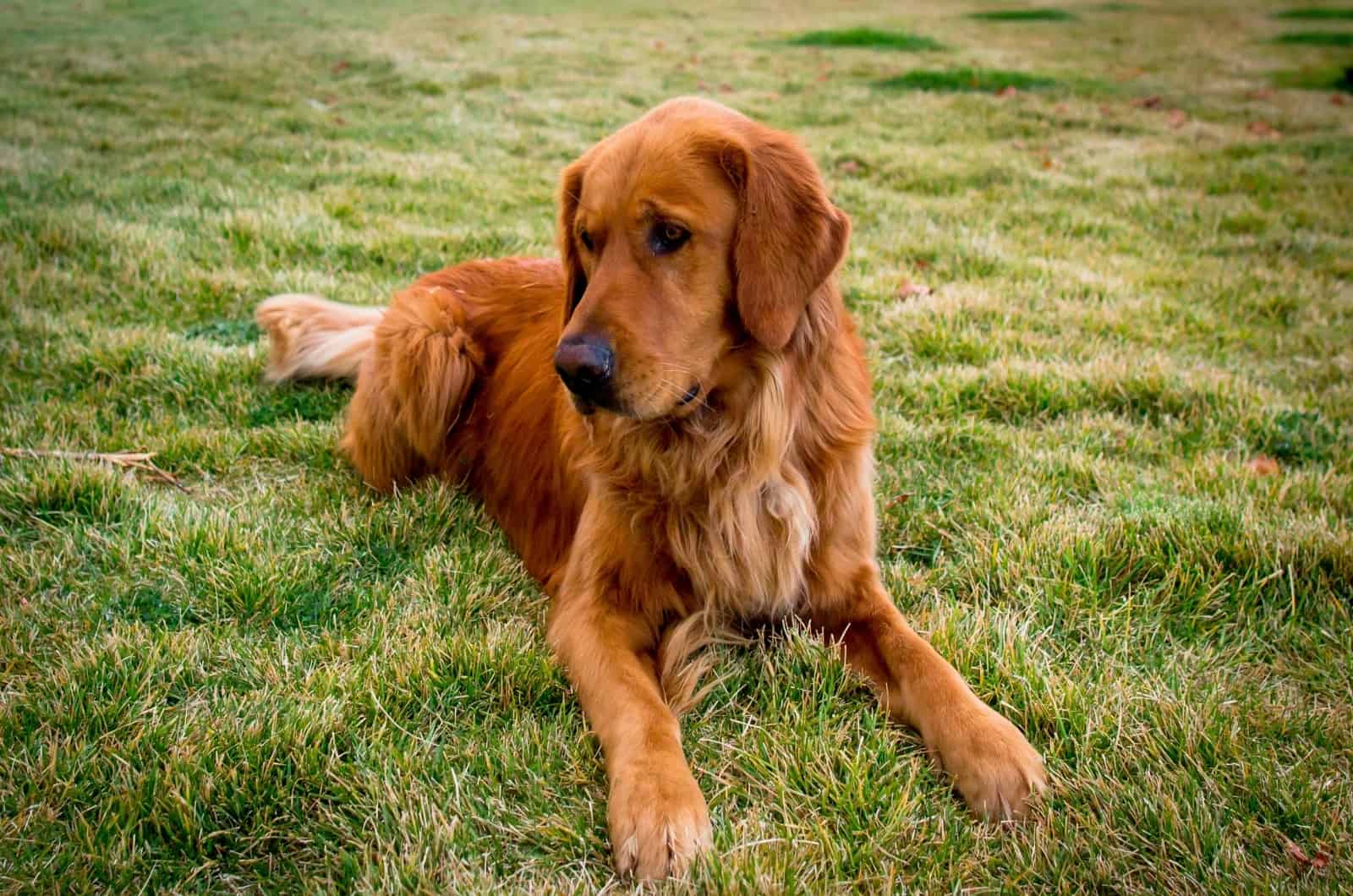If you are the type of person who likes the idea of Golden Retrievers, but you think that your daily activity levels would be too much for the standard Golden Retriever, I have the perfect solution: A Red Golden Retriever!
These dogs have a lot more energy than the standard Goldens since they were used as hunting dogs as well as search and rescue dogs. Thanks to their genetics, they have a lot more energy, and they need a lot more exercise!
Aside from that, we cannot go by without noticing the beautiful red coloring of this Golden’s coat. It is something that makes them different from other Goldies, for sure!
What Is The Red Golden Retriever?
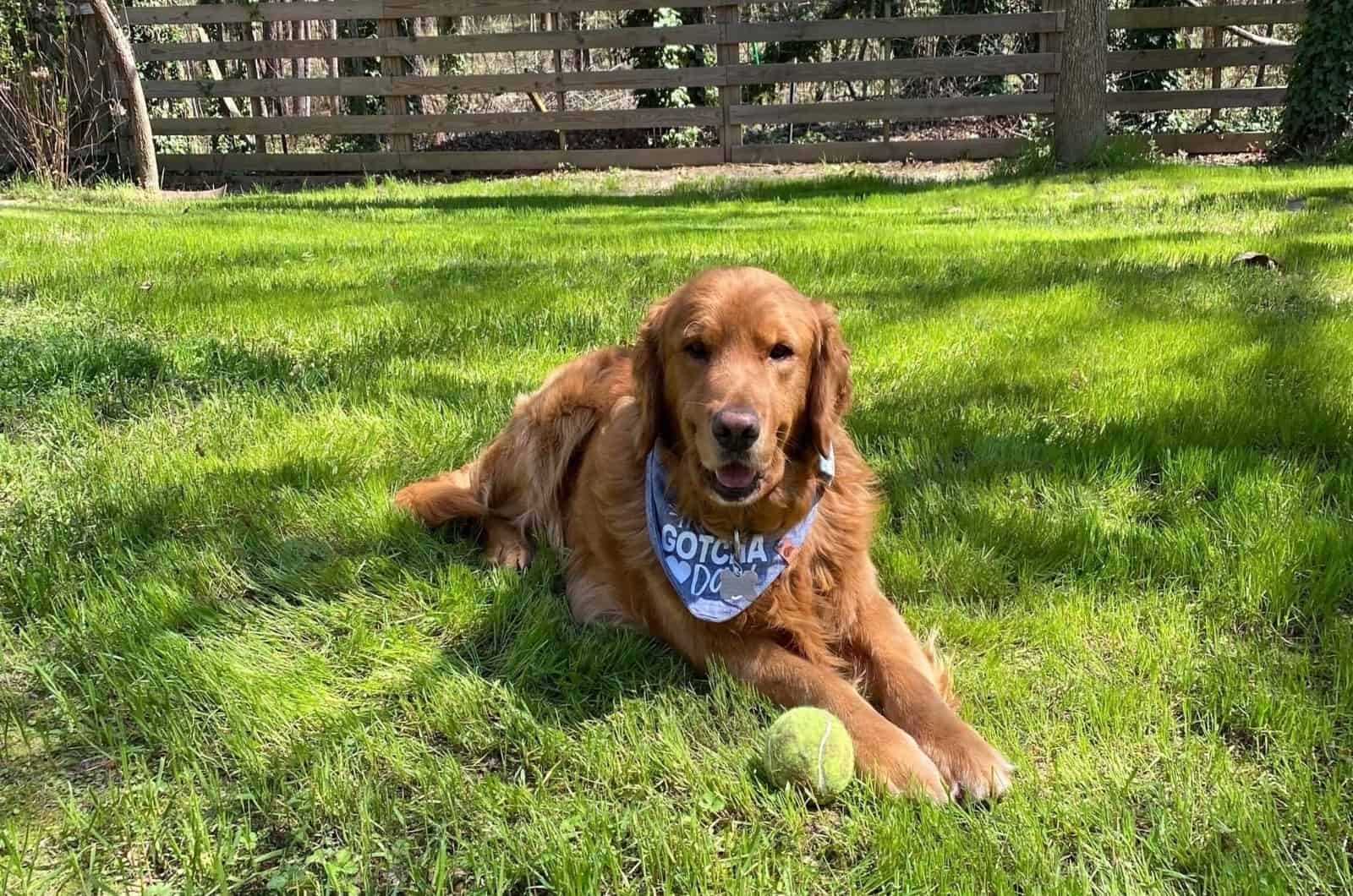
Having a darker coat than other golden retrievers, the Red Golden Retriever is indeed a naturally-occurring variant of the breed. The coat is called mahogany, with a characteristic red hue.
The Red retriever stands out because of its unmistakably red color, which is very different from the other, standard-colored Golden Retrievers.
Red Golden Retrievers are consequently prohibited from competing in dog shows as they are regarded as abnormal.
Red golden retrievers will keep their mahogany hair color throughout their entire life, unlike other Golden Retrievers whose fur tends to brighten or darken as they age.
What Is The Difference Between The Red And The Other Retrievers?
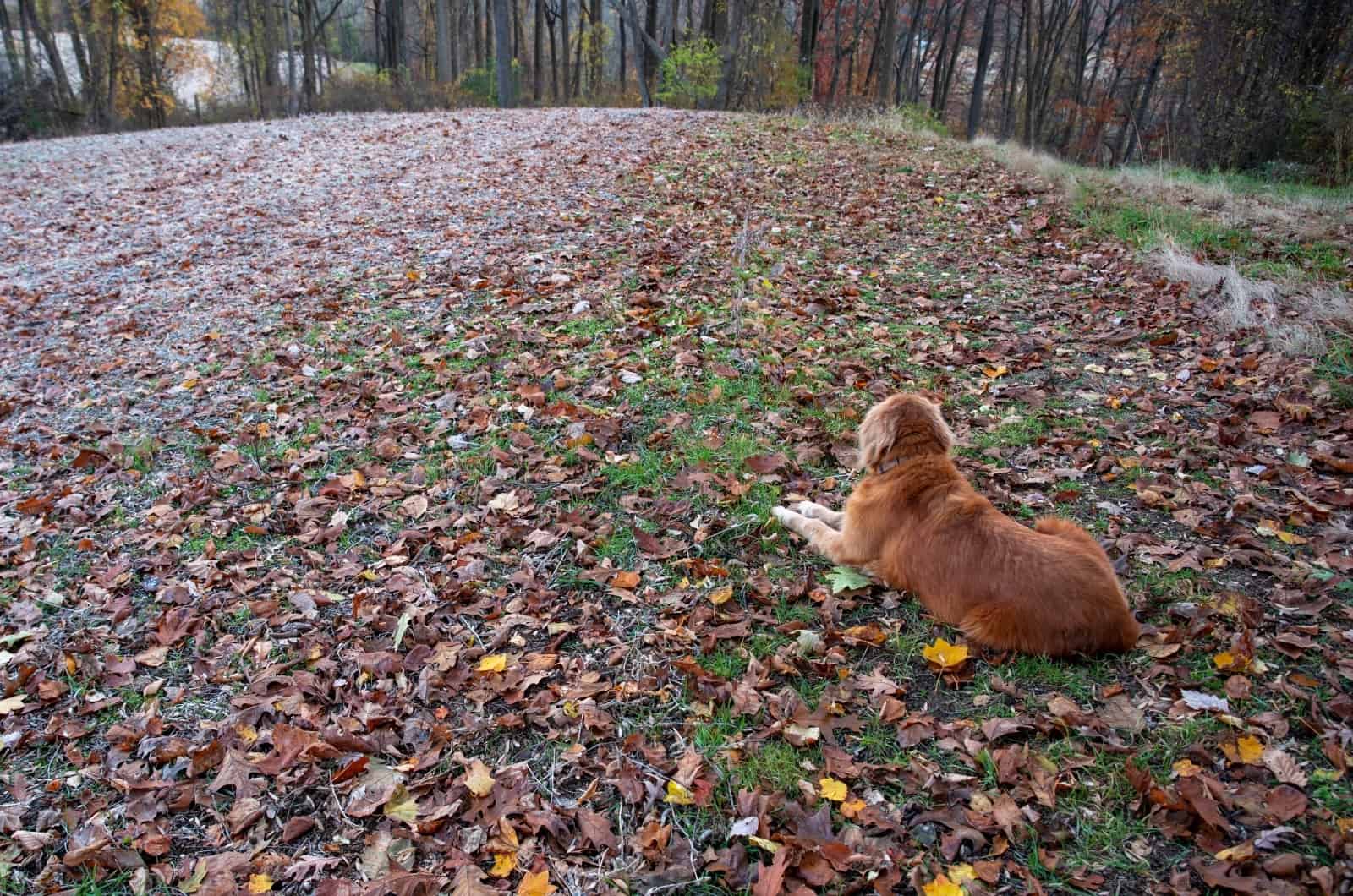
Whereas the color is the primary distinction between red golden retrievers and regular golden retrievers, there seems to be a few other distinctions to be mindful of.
It is important to note that these variations are not caused by the same genetic factors that give red retrievers the distinctive mahogany color.
Red retrievers, on the other hand, usually descend from hunting lineages, whereas the majority of other goldens are raised as companions, therapy dogs, or show dogs. As a result, many traits have taken center stage.
Red Golden Retrievers typically weigh less, and are a little bit smaller than other golden retrievers.
Male red retrievers often weigh between 65 and 75 pounds, and stand 22 to 23 inches tall, although regular golden retrievers may acquire an additional inch or two.
Red retrievers are typically 20 to 21 inches tall, although regular golden retrievers may be an inch taller. Female red retrievers would again weigh between 55 and 65 pounds, which is the typical range for Golden Retrievers.
They require a little more activity due to their tendency to have a more athletic and sleek frame than other Goldens, and also because they have more energy.
Red retrievers are therefore the smallest members of the Golden Retriever breed.Their coat has a slightly distinct texture as well. These dogs have quite a short undercoat as well as a larger top coat, much like all Goldens, which helps them stay warm in cold weather.
Red Golden Retrievers are one of the low-maintenance dog breeds. In order to maintain control over their coat, Retrievers must be brushed at a minimum of once every week.
The History Behind This Dog Breed
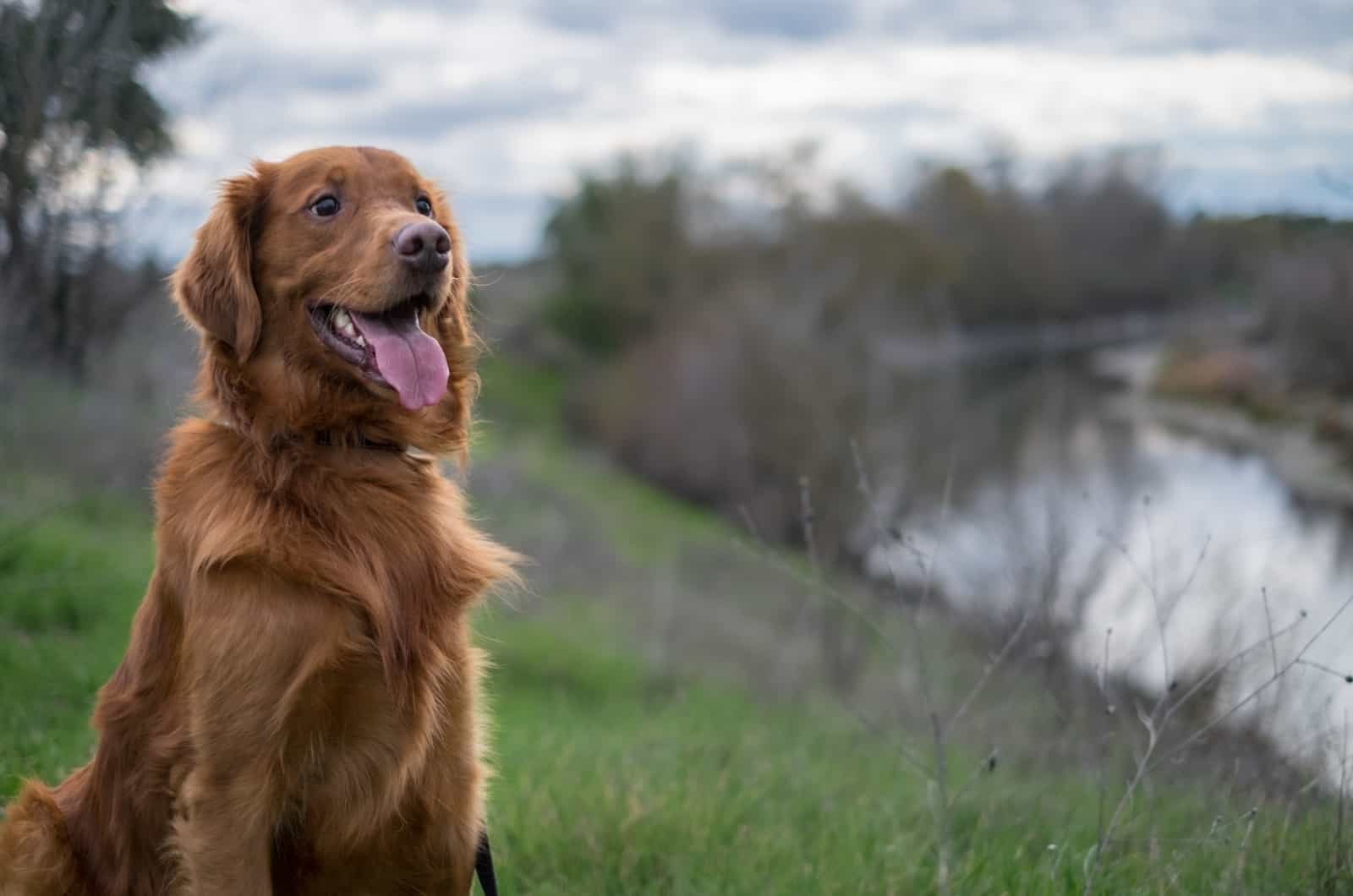
In the Scottish Highlands, throughout the mid 19th century, when wildfowl hunting had become a common occurrence, golden retrievers were developed as gun dogs.
Because the hunting fields were speckled with marsh ponds as well as rivers, the retrieving dogs were required to cover more terrain to gather game.
The 1st Baron Tweedmouth, Dudley Marjoribanks, which owned a lavish estate close to Glen Affric, in Scotland, was chiefly responsible for the development of the breed.
According to legend, the very first generation of Golden Retrievers was produced when Lord Tweedmouth mixed a wavy-coated golden and then a Tweed water spaniel in order to produce a dog that was proficient at retrieving game both on land as well as in water.
Despite being bred originally as hunting dogs, they now perform a variety of different tasks such as being therapy dogs, support animals, service dogs, as well as search and rescue dogs.
However, as the majority of red Golden retrievers were field-bred, they typically excel at the activities for which they were originally developed: hunting, as well as working outdoors.
And, considering that goldens were selected to be hunting dogs, that influenced a lot about who they are today, including their size, disposition, level of energy, and the kind of household they belong to.
The American Kennel Club (AKC) accepted Golden Retrievers for the first time in 1903, and they were first displayed in 1908. In 1911, they were recognized as the current breed by law.
Following being brought to the country by Dudley Marjoribanks’ sons, it required additional 14 years for this dog breed to be acknowledged in the U.S., following which the breed rose to popularity.
Red retrievers with a mahogany coat are a variety of the Irish setter, often recognized as a red setter, which has mahogany as a common hue.
How Does The Red Golden Retriever Look?
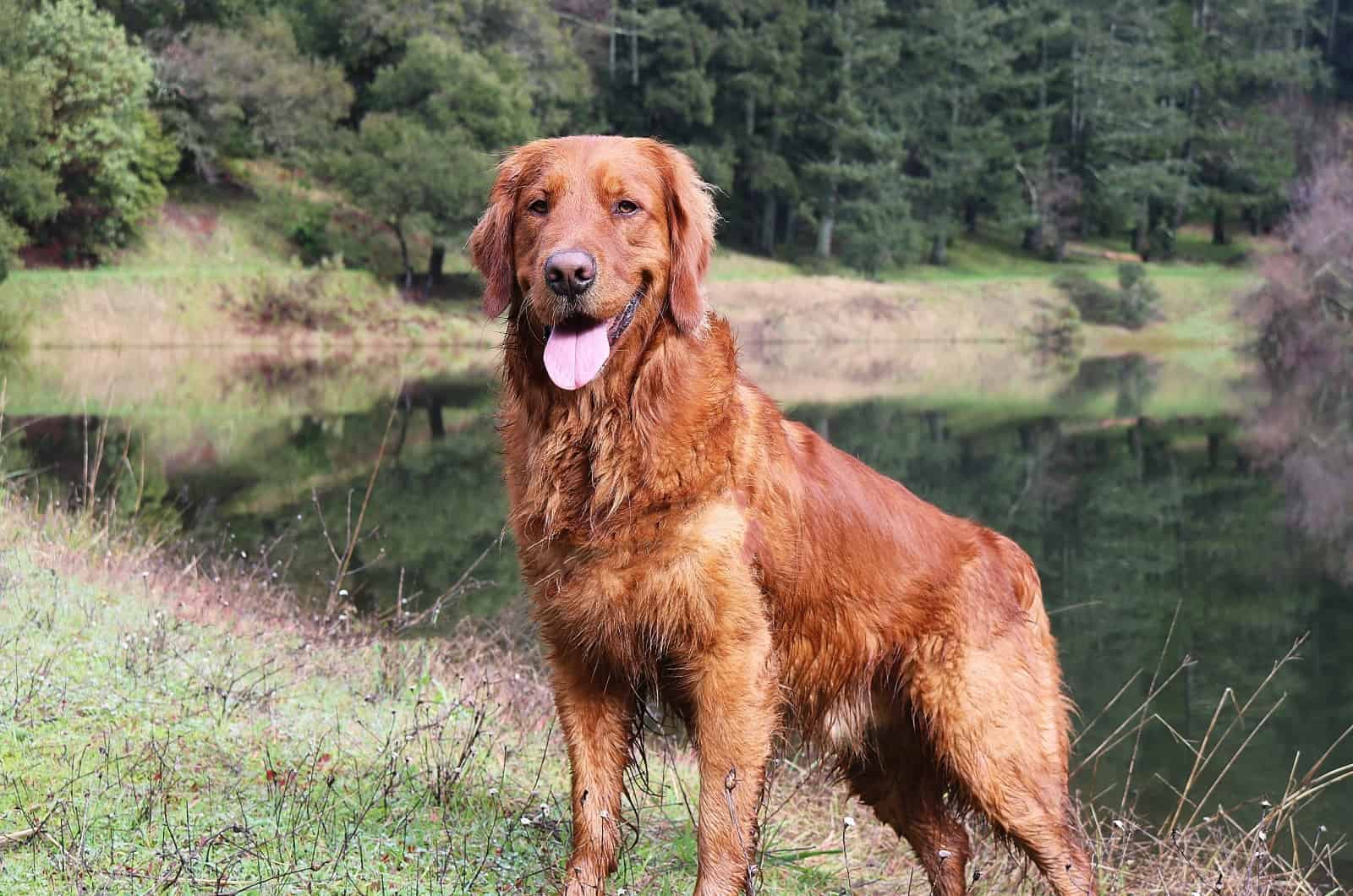
When the Red Golden Retriever was developed in the 19th century, it is thought that the Irish Setter, one of his predecessors, contributed to the color of his coat. Red is the characteristic coat color of the Irish Setter, and the Golden Retriever must have acquired this hue.
The Golden Retriever’s coat gradually turns nearly white or dark golden red as it ages, while the Red Golden Retriever, with the exception of a few gray hairs, retains its rich mahogany color all of his life.
The Red Golden Retriever has a Golden Retriever-like appearance, but he also has a few minor differences.
In comparison to a female Red Golden Retriever, which weighs 55 to 65 pounds, and stands 21 to 22-and-a-half inches tall at the wilts, a male Red Golden Retriever may weigh approximately 65 to 75 pounds. They have long, shiny hair, and an exquisite, elegant physique.
There is a good likelihood that the Red Golden Retriever puppy may fall on the shorter as well as lighter end of the weight and height range if it was born into a hunt or sports background.
This is so that the working lineage, which is more athletic and better suited for hunting than the conformation ring, can be used. You will discover that your Red Golden Retriever is the tiniest in the Retriever puppy group, despite the fact that he won’t be noticeably shorter.
You shouldn’t pick a Red Golden Retriever if competing with your Golden Retriever in conformation shows is important to you. If they are excessively red, they cannot be allowed in the ring, according to the AKC’s breed regulations.
How To Understand The Coat Color Genetics
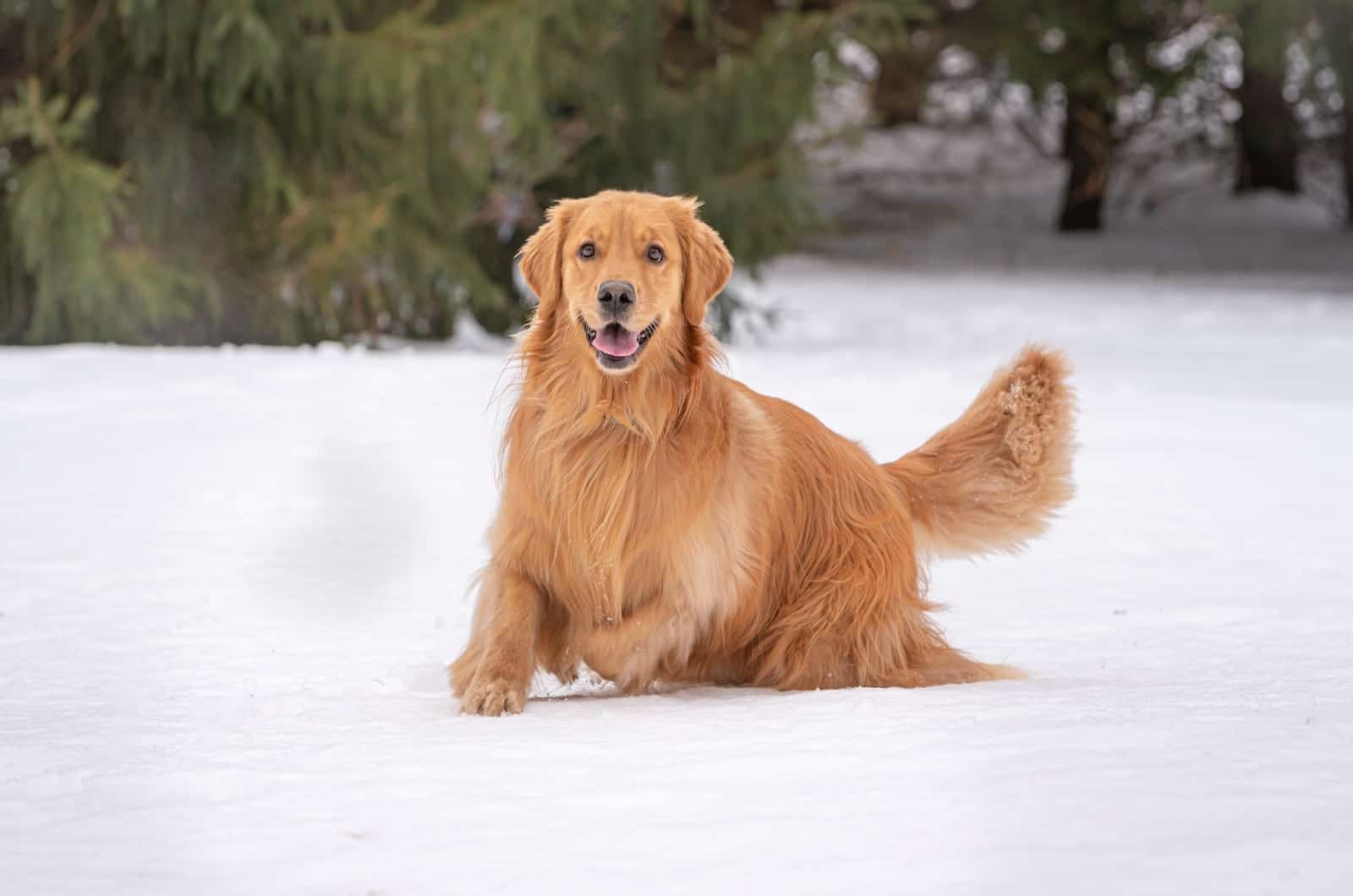
We need a brief scientific lesson to comprehend this. The 39 chromosome pairs make up each canine cell, with the exception of the egg cells and sperm cells. Both parents contribute – one from the Mama dog, and another from the Dad dog, to each pair.
Only about 10 of the 50,000 – 100,000 D.N.A. genes (which are found on each of these chromosomes) are responsible for coat color.
The 10 genes affect color in a variety of ways, including how it is distributed (e.g., in spots or stripes), how intense it is in each hair or over the entire coat, and how it is expressed.
The two genes he inherits from his parents could either be distinct or identical. Some genes are recessive while others are dominant, and naturally, dominant genes will cover over recessive genes.
A pair can be “Aa,” where “A” stands for the dominant gene, and “a” stands for the recessive gene. When both the big “A” and the little “a” are paired, the dog will appear as “AA” because “A” hides “a.”
Therefore, the B, E, and C portions on the chromosome are recognized to be crucial markers for color in Golden Retrievers. Color is determined by B & E, whereas shade or intensity is influenced by C.
Thus, the C gene becomes “C” and “cch.” CCH is the recessive gene, whereas C would be the dominant gene.
What Kind Of Coat Should The Red Golden Retriever Have?
Any lighter or darker hue of Golden is not acceptable; only rich and bright Golden tones are acceptable.
The Red Golden Retriever can maintain body heat while working in cold and abrasive conditions, like in the Scottish Highlands, thanks to his undercoat and outer coat.
Its long, wavy, velvety outer coat contrasts with its short, dense undercoat to give it an attractive appearance.
It will have a shorter outer coat than the typical Golden Retriever. It can get game from the water while wearing this lovely coat because it is water-resistant in addition to being very pleasing.
Its tail also exudes elegance in addition to the color and texture of its coat. It is long, covered in plumes of hair, and always carried “with a joyous movement,” as the AKC might put it.
Its mouth, eyes, and eye rims, as well as its nails, may frequently be black or dark brown, just like the Golden Retriever’s. Reputable breeders pay close attention to these things, so don’t worry!
What Kind Of Personality Does The Red Golden Retriever Have?

Red retrievers have always had the incredibly gregarious and friendly disposition of goldens, which makes them wonderful family pets. They also have a greater amount of energy than other Goldens, so they benefit from prolonged and more intensive periods of exercise.
Red Goldens are highly intelligent, which makes them simple to train. They are also observant and sensitive enough to understand what is expected of them without being explicitly informed.
This is among the factors that make Red Golden Retrievers excellent working dogs, and why they are frequently employed in jobs like handicap assistance.
Additionally, Goldens have a strong appetite. This makes them more trainable because they’ll sacrifice anything for a nice treat; however, it also makes them more likely to gain a few pounds if their food consumption isn’t balanced.
They easily form bonds with people, which makes them wonderful family pets. However, this also implies that they must be a family member as well.
They must be indoors with the family because leaving them alone for extended periods of time makes them experience separation anxiety.
They make excellent companions for children, dogs, and sometimes even strangers, but they are not excellent watchdogs.
Despite being large dogs, they don’t usually stumble over items, and their soft mouth allows them to grab items without hurting them. This means that accidents involving children at home are uncommon.
Is The Red Golden Retriever A Good Family Pet?
Red Golden Retrievers are known for their lovely and outgoing personalities; they have a naturally positive personality.
Children will find a best friend with this furry pet because they were bred to work and have a boundless amount of energy. They also enjoy nothing better than interacting with their family.
Even though they will begin to slow down as they age, they will always be pleasant, kind, and affectionate toward people.
The kindness of the Red variety is one of the factors contributing to its popularity. They are therefore suitable for a wide range of owners and lifestyles.
As long as the family dynamic is one of love and commitment, they may fit in with any family. A well-mannered Retriever enjoys playing with kids, dogs, and even other animals. When it comes to the adage, “dogs and cats don’t get along,” they are the exception.
Is The Red Golden Retriever A Healthy Dog Breed?
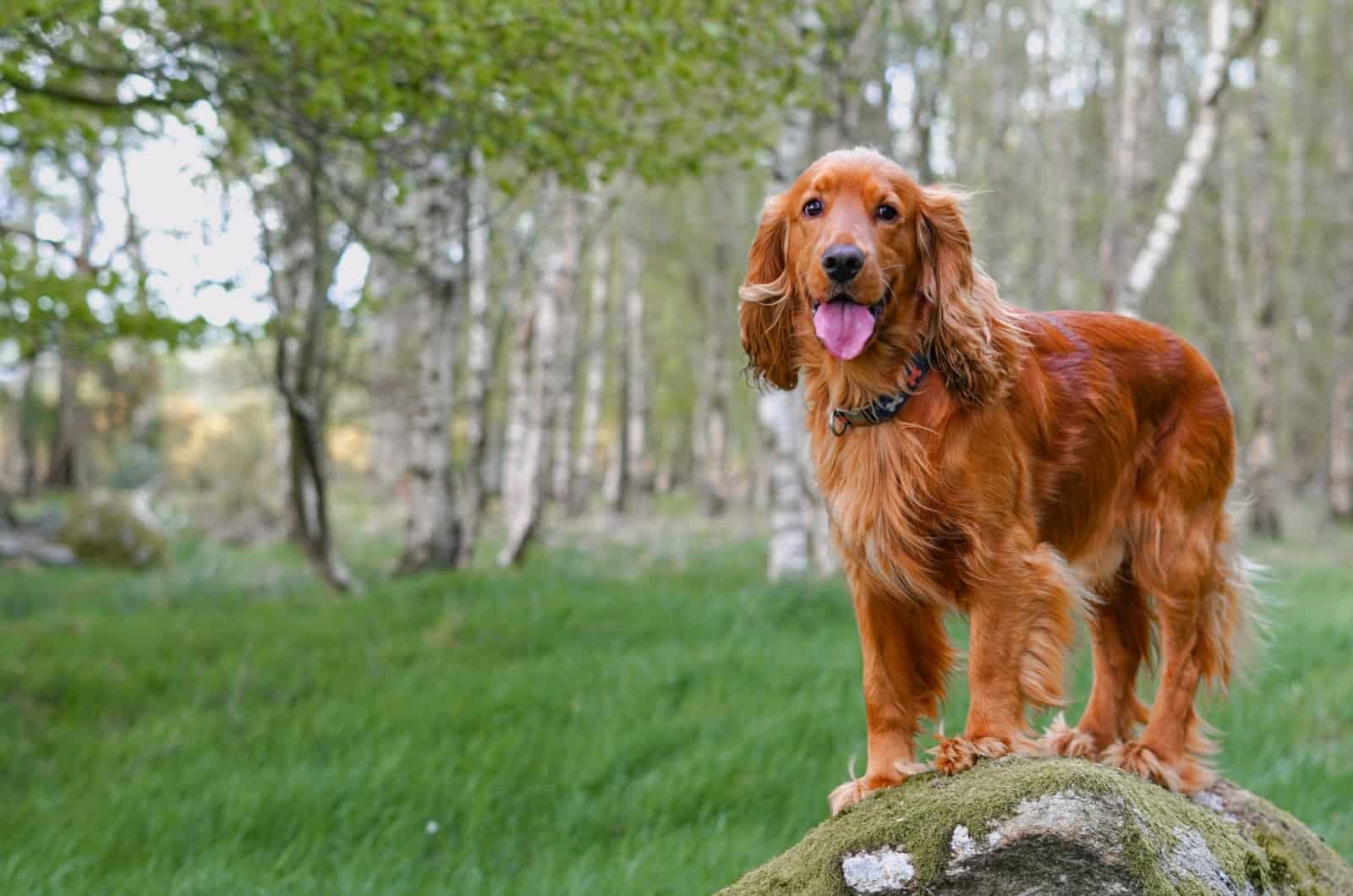
Red Golden Retrievers, like all dog breeds, have frequent health problems that you should be aware of before deciding whether or not to adopt one.
All Golden Retrievers, even Red Goldens, are highly vulnerable to cancer in their later years. There is some evidence to suggest that neutering Golden Retrievers before they are a year old causes this, and raises their risk of acquiring lymphoma or hemangiosarcoma.
By limiting the use of chemicals, such as pesticides on your grass, you can reduce the risk of cancer in your dog.
Hypothyroidism is more common in Red Goldens, and it can lead to weight gain. This is just another justification for owners of Red Goldens to watch their feedings carefully.
Along with Hock Osteochrondosis, other ailments that Red Golden Retrievers frequently face include joint problems, like hip as well as elbow dysplasia.
They are also more likely to develop the muscle tiredness disorder, myasthenia gravis. Later in life, all of these issues may result in restricted movement in Red Goldens.
Red Goldens are often susceptible to Subaortic Stenosis – a disease of the heart that results in occlusion of the heart valve. They may also develop Progressive Retinal Atrophy – a blinding degenerative disorder of the eyes.
Having all of these possible health issues in mind, we can say that a well taken care of Red Golden Retriever will be a healthy one with a long lifespan. However, you should definitely read more about these possible health problems in order to understand how to prevent them.
Possible Health Issues Of A Red Golden Retriever
The Red Golden Retriever is one of the most well-liked breeds of families and athletes alike because of its playful and adventurous nature. These strong and loving dogs can have a long, active life when they are carefully bred.
There are health hazards associated with just about any dog breed, but Red Golden Retrievers are at a higher risk than other breeds. The following are some typical health issues to look out for in your Red Golden Retriever.
1. Progressive Retinal Atrophy
The genetic eye condition known as progressive retinal atrophy (GR-PRA1) affects dogs. Although the age of onset might vary, affected dogs often start exhibiting clinical signs associated with retinal degeneration between the ages of 6 and 7 years.
On a veterinary eye exam, it is possible to see changes in reflectivity, and the emergence of a formation behind the retina, referred to as the Tapetum, as the first clinical indicators of progressive retinal atrophy.
The retina’s blood vessels weaken as the condition progresses, indicating less blood circulation to the retina.
The majority of affected canines eventually progress to total blindness after experiencing vision loss in low light (night blindness), and deterioration of peripheral vision in the beginning.
Genetic testing ought to be carried out before breeding because indications do not show up until adulthood. Breeding between known carriers is not advised in order to eradicate this abnormality from parental genotypes, and prevent the possibility of producing afflicted pups.
There is no higher risk of afflicted puppies in dogs that have not been found to carry this particular mutation.
However, a screening test in SLC4A3 does not rule out progressive retinal atrophy in a lineage because there are other kinds of progressive retinal atrophy brought on by mutations in other genes.
2. Hypothyroidism
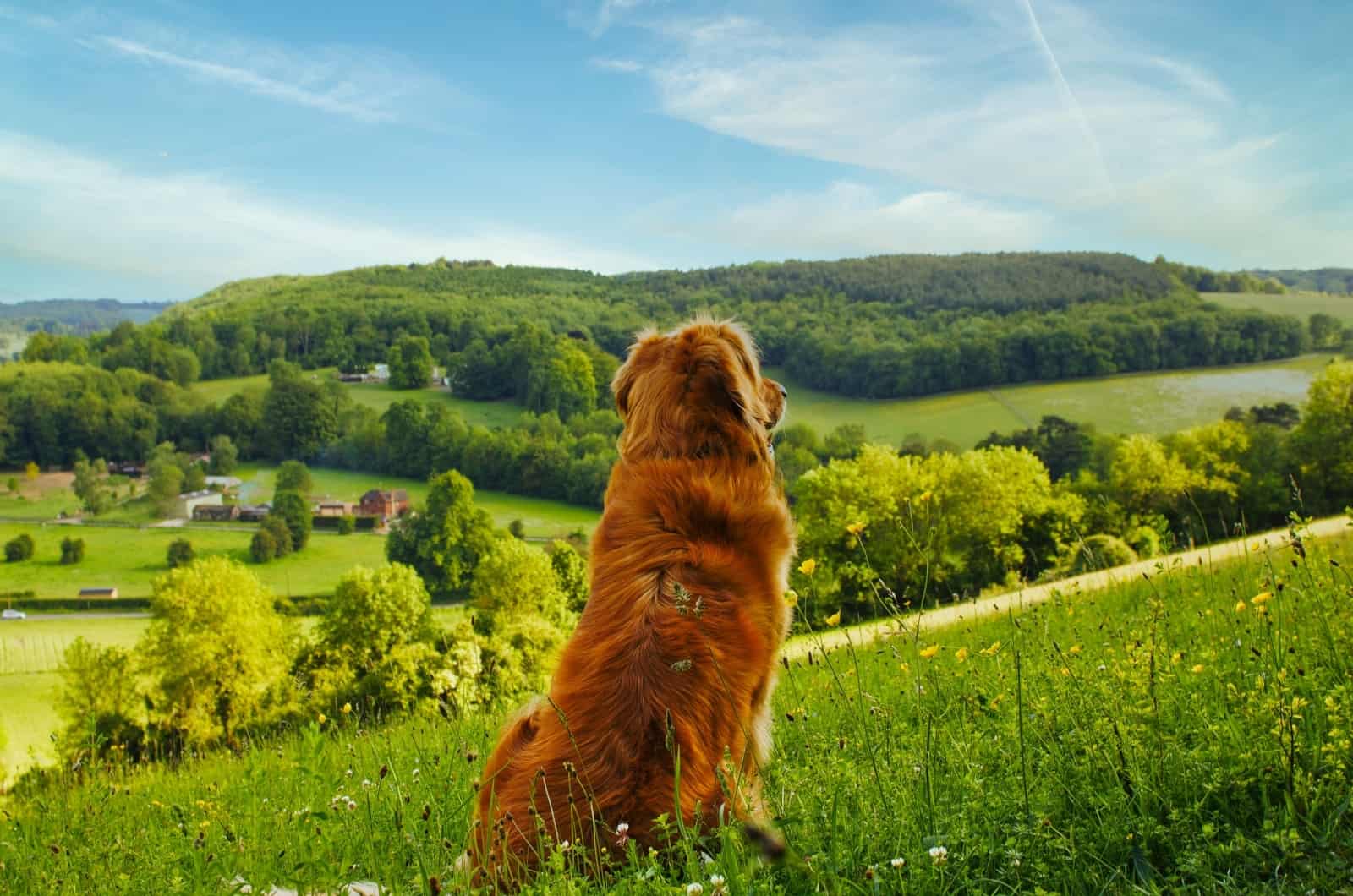
The thyroid gland controls how quickly the body burns food. The body’s digestion is enhanced if the thyroid gland is hyperthyroid (overactive). The metabolic rate slows down if it is hypothyroid, which is when it is underactive.
Hypothyroidism in dogs is typically brought on by either sporadic thyroid gland atrophy or lymphocytic thyroiditis. The former condition, which is assumed to be a completely resistant condition, is the most frequent cause of hypothyroidism.
This indicates that the thyroid gets attacked by the immune system once it determines that it is aberrant or foreign. Although the cause of this is unknown, it is a genetic trait, which means that genetics is involved in this illness.
Normal thyroid tissue is substituted by adipose tissue in idiopathic thyroid gland atrophy. Additionally, little is known about this illness.
More than 95% of instances of hypothyroidism in dogs are due to these two reasons. The remaining 5% are brought on by uncommon illnesses, such as thyroid carcinoma.
Although treatable, hypothyroidism cannot be cured. Thyroid replacement hormone is administered orally to treat it.
The dog will require this medication for the remainder of its life. Levothyroxine, an artificial thyroid hormone replacement drug, is the most frequently suggested treatment.
This may lead to hyperthyroidism symptoms, such as hyperactivity, insufficient sleep, weight loss, as well as increased water intake.
It is crucial that hypothyroidism be effectively managed because the thyroid gland serves as a crucial gland. Please get in touch with your veterinarian if you have any inquiries related to this condition or if you are worried about how your pet is responding to treatment.
3. Elbow Dysplasia
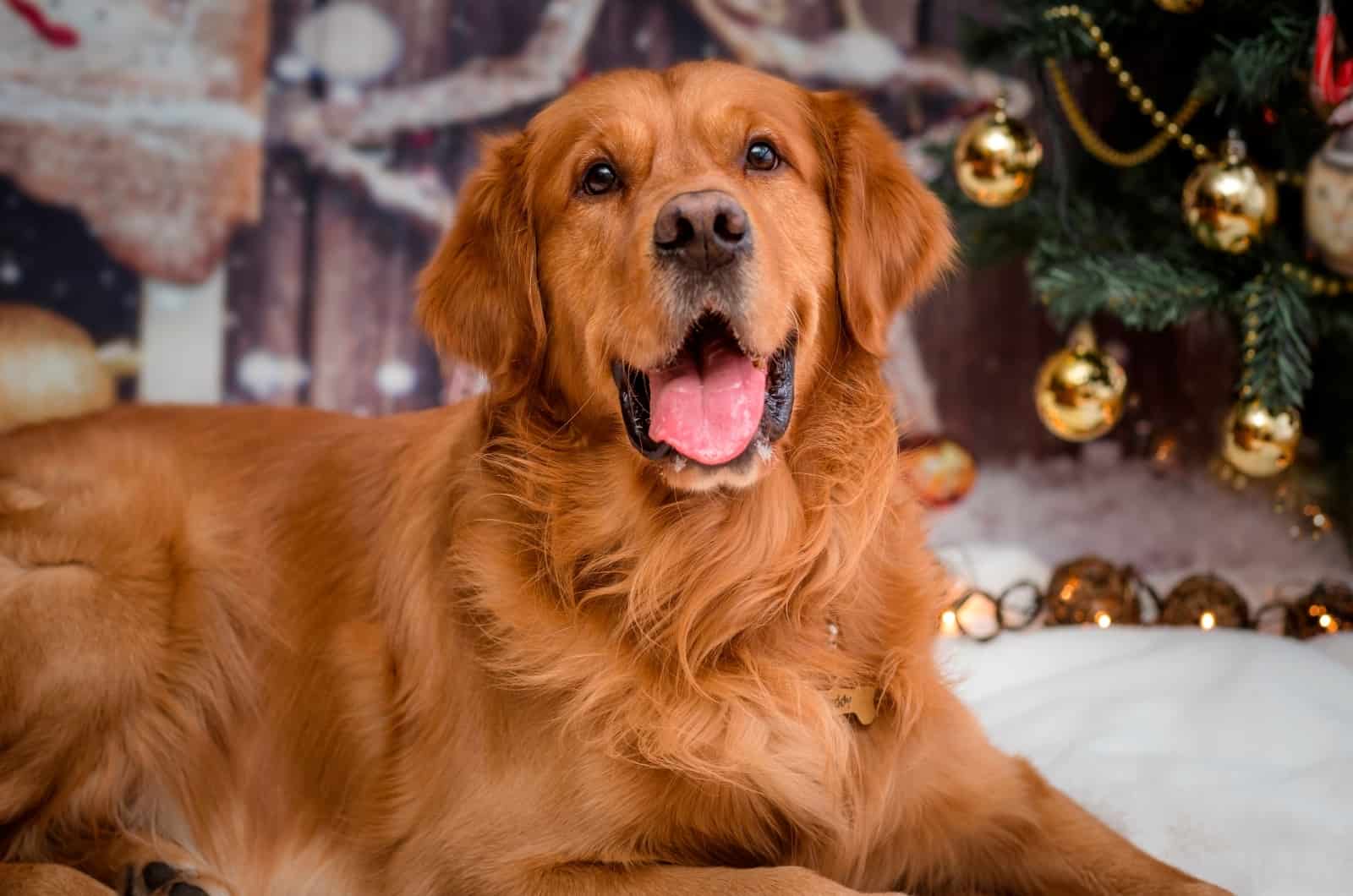
Three bones: the ulna, the radius, and the humerus, make up the dog’s elbow joint. For the joint to work properly, these three bones must fit together properly. In order to keep the elbow stable, it has ligaments on both the inside and outside.
Dog elbow joints share anatomical similarities with human elbow joints; however, because dogs balance on their front legs, different stresses are imparted to the canine’s elbow. The radius as well as ulna bones make a C-shaped curve that the humerus bone may easily follow.
Young, large-breed dogs frequently get elbow dysplasia. Some dogs grow with a step between both the radius, and also the ulna bones, which may be caused by the radius bone becoming too long or too short in relation to the ulna.
The bone may then either develop cracks along the lines of highest stress or stop growing regularly. This procedure may potentially harm the cartilage in the joints. Disruption of the bone and cartilage leads to the development of arthritis.
Generally, impacted dogs have front-leg lameness, which can begin in as early as 5 months of age. The limping may come and go, getting better with rest, and getting worse with exercise. Dogs suffering from elbow dysplasia do not always exhibit symptoms.
Some canines with elbow dysplasia will get better without surgery. Controlling symptoms is the goal of medical care. Exercise should be regulated, and the dog shouldn’t be allowed to gain weight.
Fish oil has cartilage-protecting substances that may aid in joint lubrication and bone health. In general, supplementation is required for life.
Anti-inflammatory drugs (also known as aspirin-like medications) may be useful in relieving pain, but they ought to be used sparingly. Arthritis does not cease progress despite medical treatment.
4. Subaortic Stenosis
The weakening (stenosis) of the aortic valve’s undersurface, known as subaortic stenosis, results in some obstruction or stoppage of blood circulation throughout the heart.
The degree of the narrowing might be minor, medium, or extreme; if it is moderate or extreme, the heart may have to work harder, which could be dangerous for the dog’s health.
The condition known as subaortic stenosis is more common in dogs than in cats. Large-breed canines are the ones most likely to develop it. The onset of subaortic stenosis may either occur at birth or within the first year of life, and its hereditary origins are thought to be to blame.
The presence of mild subaortic stenosis is undetectable. Subaortic stenosis can cause symptoms like weakness, dyspnea, syncope, and in severe situations, rapid death. These symptoms can occur in both mild (rarely) and severe (nearly always) cases.
Recognize that even severely stenotic dogs can appear to be in wonderful condition and activity. Most of the time, these dogs are unaware that their heart is damaged.
Even though mild subaortic stenosis has little effect on a particular dog, it is typically advised against breeding such dogs. Subaortic stenosis that is moderate or severe might produce symptoms and raise the risk of unexpected death.
Depending on the precise severity, therapies are available, and other steps (such as restricting activity) may be suggested to reduce the effort the heart has to do.
Subaortic stenosis cannot be cured. It is frequently advised that dogs experiencing subaortic stenosis should not be crossed in order to prevent passing the condition on to future generations because it is assumed to have a genetic basis.
Lifespan Of The Red Golden Retriever
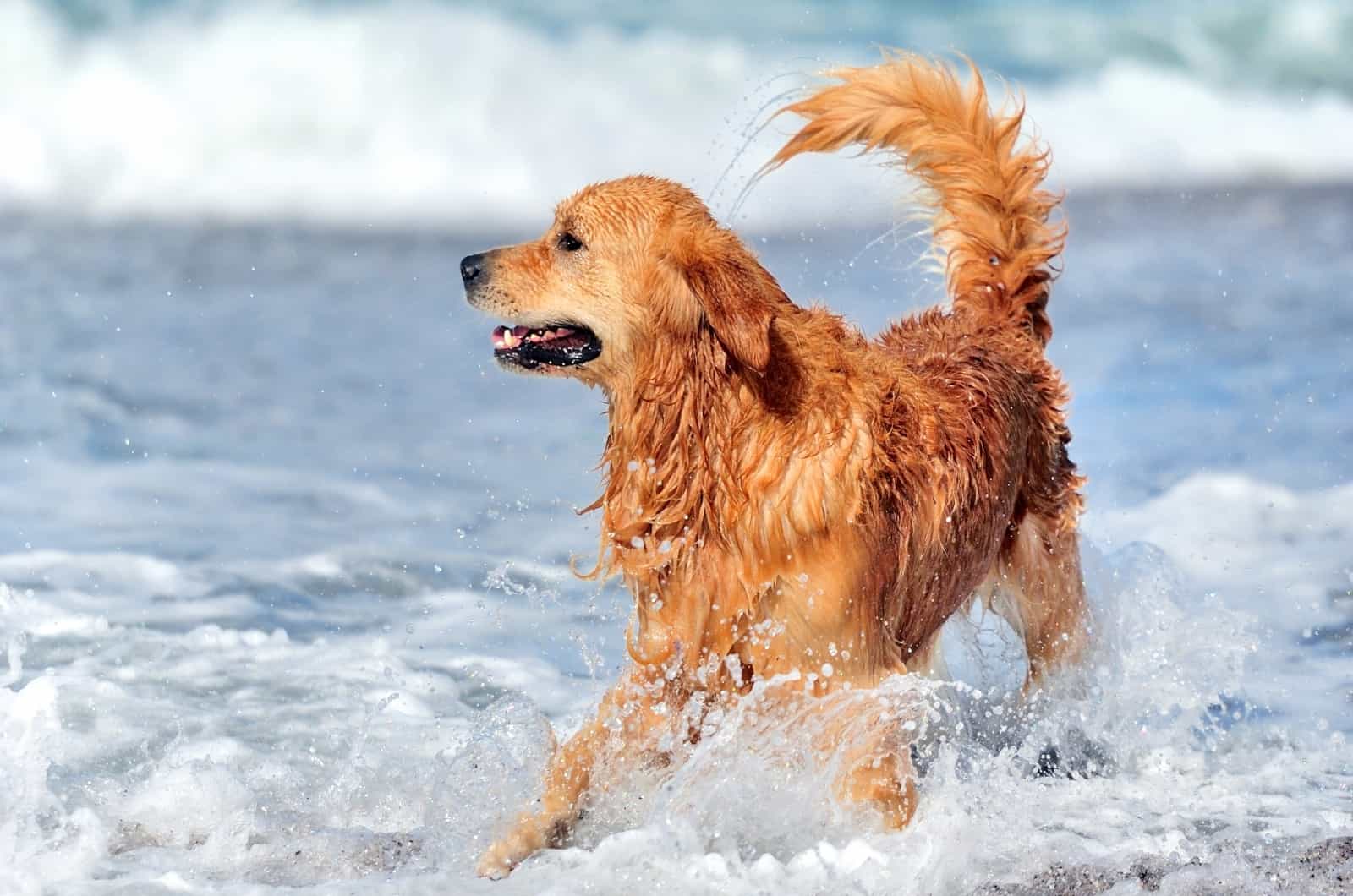
Larger dogs typically live a shorter life than smaller ones. When and why dogs passed away were examined in a study published in the American Naturalist, using information from the Veterinarian Database spanning 74 breeds as well as more than 40,000 canines.
They concluded that huge dogs age more quickly than smaller dogs. The American Kennel Club (AKC) as well as other experts estimate that Red Golden Retrievers live 10 to 12 years on average.
Sadly, the average lifespan of Golden Retrievers has been getting shorter over time. Goldens typically lived until the ages of 16 or 17 in the 1970s. Now, that is the exception rather than the rule.
Augie, a Golden Retriever, was believed to be the oldest Golden Retriever still alive when she turned 20.
Augie was adopted when she was roughly 14 or 15. She naturally received a celebration to commemorate the joyous event. The longevity of a golden depends on a variety of things, but of course, genetics plays a significant role.
American Golden Retrievers succumb to cancer 60% of the time. Less than 40% of European Goldens, however, pass away from cancer. And, even less – around 10% of Red Golden Retrievers pass away from cancer. Have that in mind when choosing among types of Golden Retrievers!
Additionally, poorly- or excessively-bred animals, such as those seen in puppy mills are more likely to experience health issues than well-bred goldens.
Of course, a dog’s lifespan can also be affected by factors like proper nutrition, exercise, and neutering.
How To Take Care Of A Red Golden Retriever
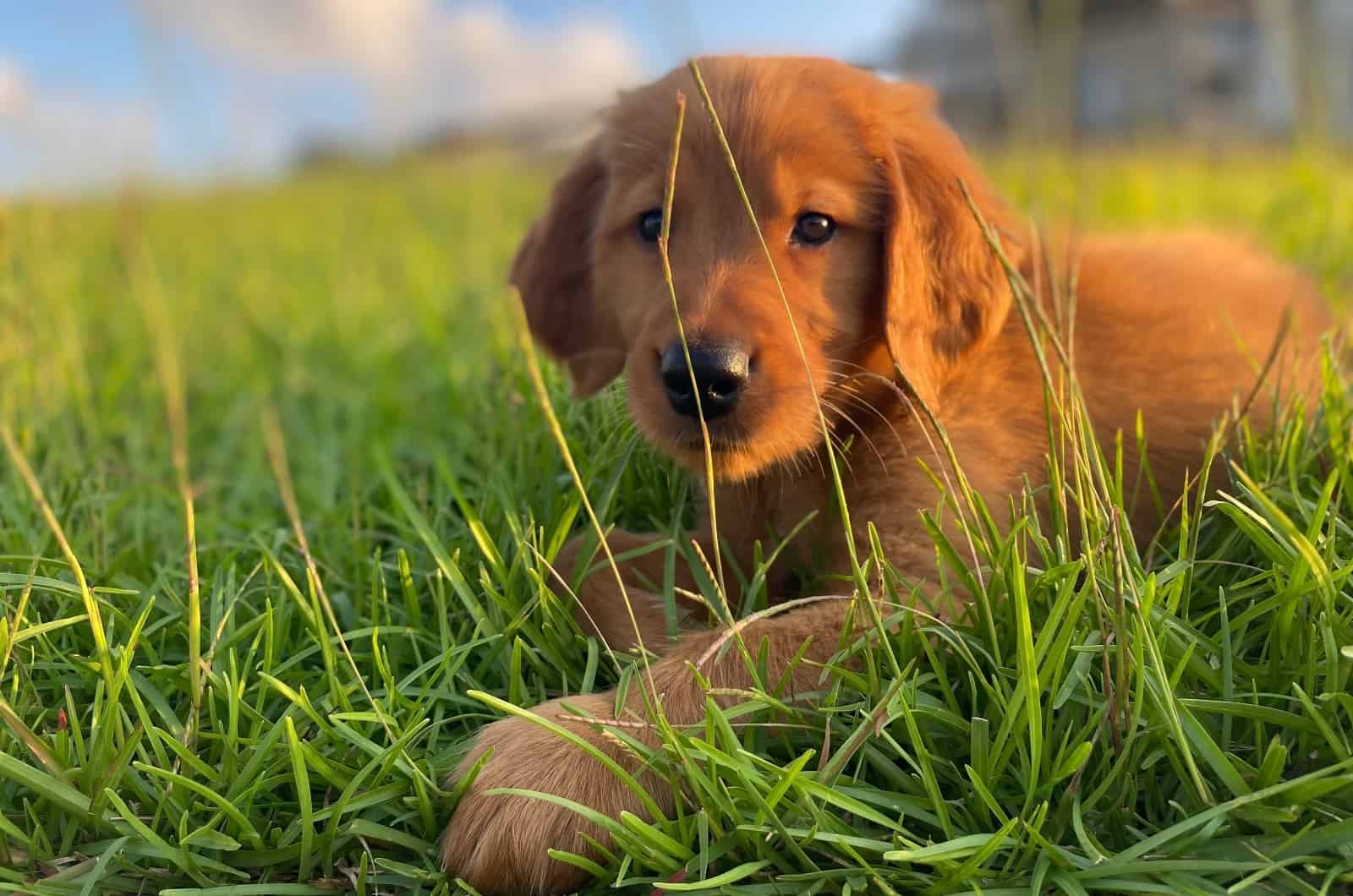
Owners ought to become accustomed to finding some dog hair on their clothes and furniture within the house. They have a double coat that is both thick and water-repellent, and it sheds profusely in the spring and fall, but only mildly in the summer and winter months.
This dog breed will need moderate care since they are not that high maintenance. They need to live in good living conditions, just as any other dog breed. With good dog food, fresh water, a nice dog bed for Labradors, and your undivided love and attention – they will be good to go.
They will need, just as every other dog breed, their regular rounds of vaccinations.
Grooming And Cleaning
The Red Golden Retriever is considerably less demanding than the typical Golden Retriever, but still more demanding than the ordinary puppy in terms of grooming requirements.
The Red Goldens’ shedding won’t seem as intense because of their significantly shorter outer coat. Naturally, they will continue to shed, but not as frequently as the Golden. They will still need to be brushed either once or twice per week, but it will take less time each time.
To keep it from tangling or growing too long, the lengthier feathering fur all around a normal Golden Retriever’s ears, neck, legs, feet, and tail needs to be cut every two months or so.
The Red Golden Retriever requires less extra care because of his less feathery fur than the typical Golden, and its coat is just less susceptible to tangling.
To keep the Red Golden smelling great, looking good, and feeling good, he has to take a bath every four weeks.
To prevent tangling and eliminate some dead hair until it covers all in sight, brush your Golden’s hair every day. A bath can also be beneficial, and is advised about once a month. However, make very sure that the Red Golden is completely dry before brushing.
Additionally, Golden retrievers will require nail trimming approximately once or twice a month. If you hear them clicking on the floor, that’s a good sign that they need to be trimmed.
Also, their teeth ought to be brushed at least twice or three times every week. It’s crucial to check the ears of Golden Retrievers since their fold-over ears foster the growth of bacteria and fungus.
Easily wipe the outer ear by using a cotton ball moistened with a moderate, pH-balanced ear cleanser if you notice any redness or an unpleasant smell. This will help prevent infections.
Nutrition
A high-energy dog needs high-quality dog food, and the Red Golden Retriever fits this description perfectly. Avoid processed, starchy foods, such as grains and vegetables, as well as fructose-rich fruits.
It would be enough to give your Red Golden Retriever 2.5 to 3 cups of premium dry dog food, divided into two or three meals.
The amount of food your adult dog consumes is influenced by his weight, gender, shape, digestion, and degree of energy. Like people, each dog is unique; thus, they don’t all necessitate the exact same quantity of food.
A dog that is really active will obviously require more food than a dog that prefers to lounge around. The kind of dog food you purchase also matters; the better the food, the more effectively it will nourish your dog, and the smaller amount you will need to toss into the bowl.
Additionally, these meals may cause inflammation, which raises this breed’s chance of developing cancer.
Food should be divided into two meals per day, totaling two to three cups. Additionally, keep in mind that your Red Golden Retriever’s daily diet should include any goodies you offer them.
It’s crucial to keep an eye on your dog’s weight because this breed is susceptible to obesity, and because Red Retriever puppies want to eat everything they see.
Training
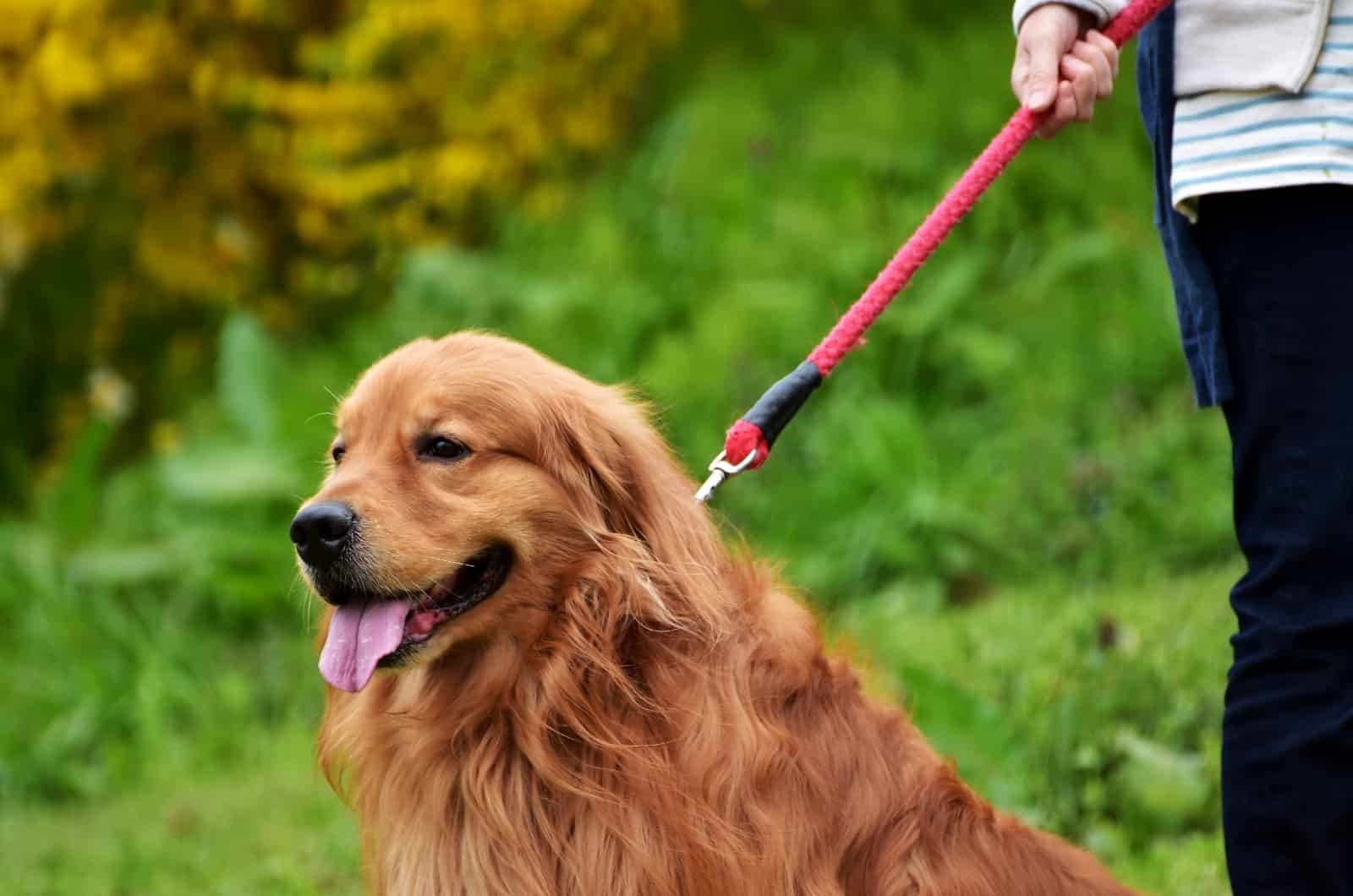
The best thing you can do for your Red Golden Retriever would be to train it. The best approach to combine a Golden Retriever’s intelligence, desire to please others, and love of goodies is through training. It also aids in stimulating their mind.
Goldens are empathetic and motivated to do well; thus, positive reinforcement is the ideal type of training for them. Now, while many of these traits make them simple to train, others make it challenging.
Due to their love of everything and everyone, Golden Retrievers can be challenging to occupy in public. They also enjoy having fun; therefore, if training isn’t enjoyable, they’ll seek another form of entertainment.
Socialization
Fundamentally, puppy socialization is showing your puppy that the world is a secure and enjoyable place during their crucial learning stages.
Your Golden Retriever puppy’s mind absorbs and stores everything from birth to 18 weeks, functioning like a massive computer system.
This is the magical stage in the Red Golden Retriever puppy’s life when they aren’t easily afraid, yet it doesn’t mean that they don’t continue to learn after this time.
For your dog’s health and well-being, puppy socialization is essential. Socialization is essential if you desire them to be capable of fitting in, and not be shunned out of fear. Here are the two primary justifications for socialization training of your dog.
Breeders can safely handle puppies for grooming or veterinary care, interact with other trustworthy humans and canines, or expose them to other surfaces, objects, or noises.
The top breeders make use of the limited chance to introduce the puppy to favorable experiences in order to provide their customers’ canines the best possible life. Take your pup to many new locations. They can go on rides in your car and take long walks all around your area.
Let them ride in the traffic, experience the wind whipping around them as a skater or cyclist passes, and sit alongside you at an outside café as wheelchairs roll by your table.
Take them swimming in a lake or to a playground if the weather cooperates. You must make sure that you don’t confine their life to the boundaries of your house.
Even while it could feel intimidating to socialize your puppy throughout these crucial few stages, your future self as well as dog will appreciate it. A little work during puppyhood will result in a canine co-pilot that is well-suited for all of life’s adventures!
Exercise Needs
Golden Retrievers adore outdoor romps, and are made for adventure. Your Golden would be pleased to accompany you on any hike or jog that you enjoy. Goldens love to retrieve, so if you feel like throwing a ball in the yard, they’d be beyond happy to join you.
Your dog will remain calm when he returns inside if you exhaust him with 20 to 30 minutes of strenuous activity twice a day. However, procrastinating could result in behavioral issues.
Similar to certain other retriever varieties, Red Golden Retrievers are inherently “mouthy,” and they are genuinely happy when they are carrying something in their mouth, such as retrieving a ball, a stuffed toy, a newspaper, or—best of all—a stinky sock.
Wait until your Red Golden Retriever puppy is at least two years old and has fully-developed joints before letting him run and play on very hard surfaces like concrete. Both common playground activities and puppy agility training are acceptable.
Final Word

If you have ever encountered or had a Red Golden Retriever, it’s clear why they are one of the most popular dog breeds, and have been for many years. Both active singles and families will like their new puppy’s personality!
When you combine all of that excellence with the unique color of this marvelous Red Golden Retriever, you get a canine superstar whose talents and beauty will wow even the most jaded dog lovers.
Its red coat, which is a result of crossbreeding, will have a great influence on the people around you, and be prepared because everybody will want to pet your new puppy! By having a bit of Bloodhound and a hunting background, this type of retriever needs a lot of activity.
They will fit the best with active families because this is the best dog if you are a runner, swimmer, or any kind of activity-doer!
FAQs
1. What Are The 3 Types Of Golden Retrievers?
We can divide Golden Retrievers into two distinctions: by color, and by the country/area they are from!
The American Golden Retriever, the English Golden Retriever, the Canadian Golden Retriever, and the British are the four distinct breeds of Goldies if we are taking the country/area approach.
Each of these varieties of Goldens has a very similar body type, and will act in the same way, although having minor variances. Remember that there are only these specific subcategories of Golden Retrievers.
When we look at the color perspective, Golden Retriever colors can be looked upon as the following:
• Standard Golden Retriever
• Light Golden Retriever
• Dark Red Golden Retriever
• Dark Golden Retriever
• English Cream Golden Retriever
2. What Is The Rarest Color Of A Golden Retriever?
Let’s be real… when we imagine a Golden Retriever, we imagine a Cream Golden Retriever, or actually, a Golden one.
However, when we are talking about the rarest colors of Goldies, the red coloring is definitely the rarest when it comes to the Golden Retriever breed standard.
Rich, vivid red is typically considered as the rarest hue for Golden Retrievers. Red-colored Golden Retrievers are frequently confused with Irish Setters because they have straighter, shorter hair that doesn’t ruffle as significantly around the legs and tail.
The darkest color that can be used on purebred Golden Retrievers is crimson – a hue that is not frequently permitted at dog exhibitions across the world. Despite not having the same amber undertone, dark Golden Retrievers resemble their red cousins.
3. Are Red Golden Retrievers Hypoallergenic?
Topics about what dog breeds seem to be hypoallergenic frequently comes up. Unfortunately, and not for the purpose you might think, Goldens lack this trait.
According to common belief, Golden Retrievers actually shed, which makes them naturally quite un-hypoallergenic.
But, the situation is a little more nuanced than that. Actually, a dog that is hypoallergenic does not exist. Those who have dog allergies are allergic to pet dander – not dog hair. All dogs induce allergies since they all produce dander.
However, if you are looking for a Golden Retriever dog breed that has hypoallergenic traits, we recommend the Goldendoodle. The Goldendoodle is a crossbreed of a Golden Retriever (of any color) and a Poodle.
Having a Poodle parent makes this mixed dog breed hypoallergenic because Poodles are among the hypoallergenic dog breeds.
4. Can I Have A Recommendation For Some Reputable Golden Retriever Breeders?
Red Golden Retrievers are bred by Ridley’s Red Retrievers, with the intention of becoming therapy dogs and helping people with disabilities.
This does not imply that you must have a condition in order to buy a Red Golden Retriever from them; it simply means that their Red Goldens will possess all of the traits desired in therapy dogs.
To make their Red Goldens more hypoallergenic, this breeder has cleverly begun introducing Goldendoodles to the red Golden Retriever bloodline, which is fantastic for anyone who has allergies.
On their website, they offer plenty of advice for first-time pet owners, and they even recommend which food brands to buy for your dog.
